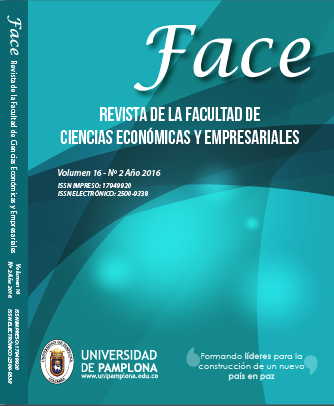Impacto socio-económico, financiero y legal del comercio de celulares lícito e ilícito en Florencia Caquetá
DOI:
https://doi.org/10.24054/face.v16i2.1235Palabras clave:
Negocio, impacto, hurto, ingresos, raponeo, violencia, IMEI, prevalenciaResumen
La cantidad de hurtos de celulares presentados en Colombia, influyó para que el tema del comercio de estos aparatos tecnológicos, se considerara como objeto de estudio social y económico, con él se logra identificar las posibles repercusionesque deja como resultado esta actividad ilícita, que se puede convertir en opciones de ingresos económicos para los criminales y negocios lucrativos para los comerciantes. El objetivo de la investigación fue estudiar las variables obtenidas por medio de una encuesta aplicada a la muestra de 383 personas, tomada del total de la población de Florencia Caquetá, que fue 163.323 para el 2012, y así identificar qué tipo de personas, cuando, donde y realizando qué actividades, se convirtieron en víctimas de hurto de celulares, de la misma forma se pudo establecer cuál es la gama y el rango del precio del celular hurtado, su estado y lugar de
compra, pudiéndose determinar los impactos sociales, económicos, legales y financieros que se reflejan dentro de la comunidad.
Los resultados alcanzados indican que el 58.2% de los florencianos son víctimas de este flagelo y que el 98% de ellos no logra recuperar su celular, reflejando una afectación en las finanzas debido a que surge la necesidad de reemplazarlo, más si en muchos de los casos el acto ilícito se repite en las mismas víctimas, por otro lado viéndolo desde la perspectiva legal existen condenas con la aplicación del Decreto 1630 del 2011 y gran desinterés por parte de la ciudadanía con la ley contra el hurto de celulares.
Descargas
Referencias
Anderson-Sweeney-Williams. (2008). Estadística para administración y economía. S. R. González (Ed.). D.R. 2008 por Cengage Learning Editores, S.A. Obtenido de http://datateca.unad.edu.co/contenidos/102504/CEP/estadistica_para_admon_y_economia.pdf
Balmon, M. A. (2006). Guía práctica de análisis de datos. Cordoba. Obtenido de http://www.um.es/jmpaz/AGP1213/guia_practica_de_analisis_de_datos.pdf
Claro Colombia. (06 de 2016). Catálogo Claro. Obtenido de http://catalogo.claro.com.co/
Consulta de la Norma. (24 de julio de 2000). Obtenido de Alcaldía de Bogotá: http://www.alcaldiabogota.gov.co/sisjur/normas/Norma1.jsp?i=6388
Dane. (2012).
Derecho Penal Especial 1. (2013). Artículo 239 Hurto. Universidad Corporativa de Colombia. Obtenido de http://tituloviipenalespecialuno.blogspot.com.co/2013/04/articulo-239-hurto_17.htm
El Tiempo. (06 de enero de 2014). El 90 por ciento de los ladrones de celulares quedan en libertad. Obtenido de http://www.eltiempo.com/archivo/documento/CMS-13338037
González, B. (16 de diciembre de 2015). 16 capturados por el delito de hurto de celulares en Florencia. Editorial Amazónico. Obtenido de http://www.editorialamazonico.com.co/index.php/judicial/4522-16-captura-por-delito-de-hurto-decelulares-en-florencia
Hernández y García, J. C.-M. (6 de octubre de 2014). Robo de celulares: una batalla que en Colombia se sigue perdiendo. El Tiempo. Obtenido de http://www.eltiempo.com/tecnosfera/novedadestecnologia/robo-de-celulares-en-colombiaanalisis-y-estadisticas-sobre-estedelito/14639855
La Nación, Florencia. (15 de diciembre de 2015). 16 capturados por robo de celulares. La Nación. Obtenido de http://www.lanacion.com.co/index.php/noticiasregional/caqueta/item/263227-16-capturados-porrobo-de-celulares
Lucio-Collado-Sampieri. (2006). Metodología de la investigación, 4ta edición. Mc GRAW HILLI INTERAMERICANA EDITORES, S.A DE C.V. Obtenido de https://competenciashg.files.wordpress.com/2012/10/sampieri-et-al-metodologia-de-lainvestigacion-4ta-edicion-sampieri-2006_ocr.pdf
Luna, D. (2014). Vamos con toda contra el hurto de celulares. Ministerio de las Tecnologías de la Información y las Comunicaciones. Obtenido de http://www.mintic.gov.co/portal/604/w3-article13111.html
Luna, M. A. (julio de 2013). Percepción sobre el decreto 1630 del 2011 que tiene los comerciantes del mercado informal del sector destapado de Armenia. 31. Obtenido de http://repository.unimilitar.edu.co/bitstream/10654/12105/1/PERCEPCI%C3%93N%20%20DECRETO%201630%20DE%202011%20.pdf
Parra F., J. C. (mayo de 2008). Análisis económico del comercio ilícito en el DMQ (Tema central). Obtenido de http://hdl.handle.net/10469/2299
Programa de las Naciones Unidas para el Desarrollo. (25 de marzo de 2015). Si una persona recibe más de $211.807 mensuales ya supera la pobreza. El Tiempo.
Rivero, D. S. (2008). Metodología de la investigación. Shalom 2008. Obtenido de http://rdigital.unicv.edu.cv/bitstream/123456789/106/3/Libro%20metodologia%20investigacion%20este.pdf
Romo De Las Salas, J. L. (diciembre de 2015). ¿Cuál es la cadena de valor y cómo se caracteriza el hurto de celulares en la localidad de Fontibón- Bogotá D.C.? Repositorio Académico Policía Nacional de Colombia. Obtenido de http://repositorio.policia.edu.co/handle/001/269
Descargas
Publicado
Versiones
- 2016-06-12 (2)
- 2022-03-12 (1)
Número
Sección
Licencia
Derechos de autor 2022 FACE: Revista de la Facultad de Ciencias Económicas y Empresariales

Esta obra está bajo una licencia internacional Creative Commons Atribución-NoComercial-CompartirIgual 4.0.





